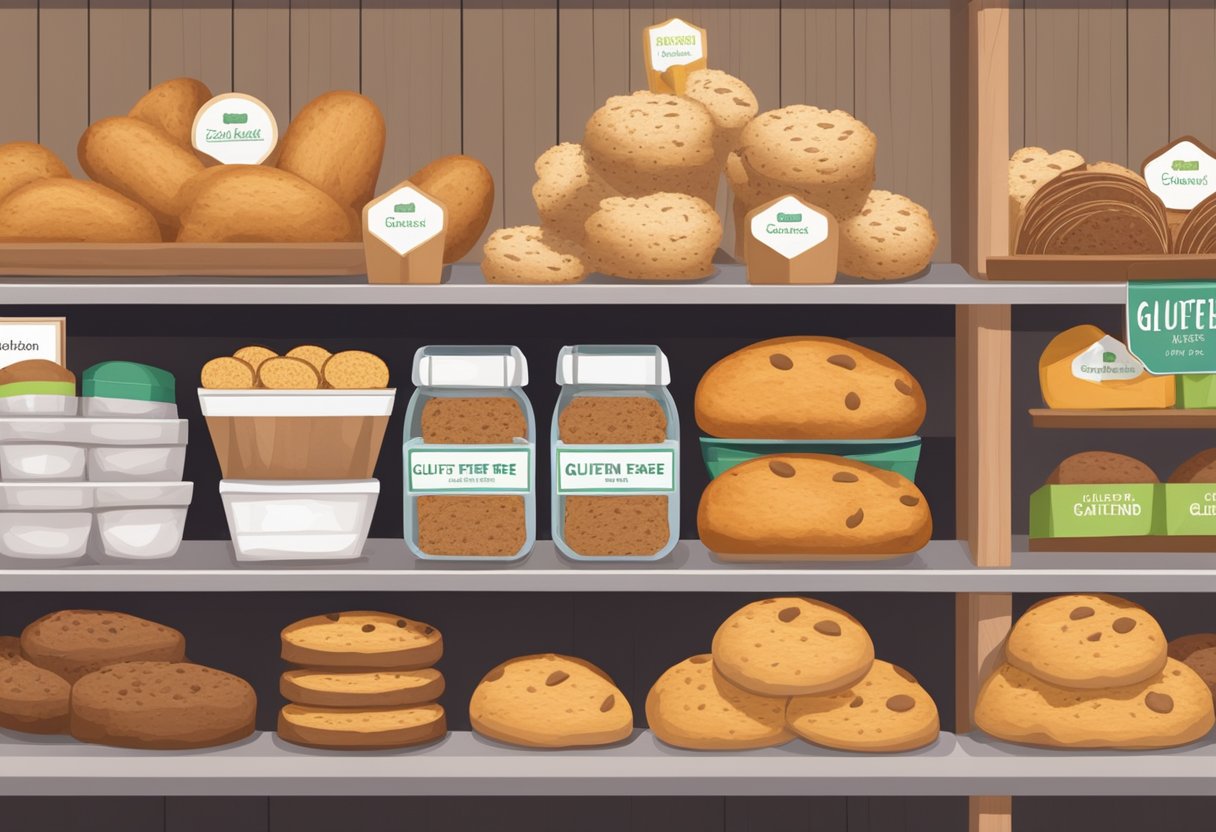With the rise of gluten-free diets due to health reasons and personal preferences, the availability of store-bought gluten-free baked goods has drastically increased. For individuals with celiac disease, gluten sensitivity, or those who choose a gluten-free lifestyle, finding delicious and safe foods is now more convenient than ever. The market has expanded beyond basic bread to include an array of products that cater to different tastes and dietary requirements, ensuring that the absence of gluten doesn’t mean a compromise on flavor or texture.

The journey to perfecting gluten-free baking has led to the creation of numerous blends of alternative flours and baking essentials. While some might think that gluten-free baking is a complex alchemy of ingredients, many companies have harnessed this knowledge to produce ready-made delights that rival traditional baked goods. Consumers can now enjoy everything from the heartiness of a 7-grain bread to the sweetness of a vanilla cake, all made without gluten. These advancements make it easier for those following a gluten-free Mediterranean diet to maintain their eating habits without feeling limited.
Key Takeaways
- Gluten-free baked goods are widely available for various dietary needs.
- Alternative flours and ingredients have evolved to produce high-quality gluten-free products.
- Store-bought options provide convenience without sacrificing taste or texture.
Table of Contents
Understanding Gluten-Free Baking

Embracing gluten-free baking can be a refreshing shift for those following a Mediterranean diet without gluten. It can offer a spectrum of flavors while adhering to dietary restrictions. There’s a bit of a learning curve, especially when it comes to choosing the right flour and understanding how non-traditional ingredients behave in baked goods.
Basics of Gluten-Free Flour Types
In gluten-free baking, the flour used is paramount in achieving the right texture and flavor. Traditional all-purpose flour, which contains gluten, is replaced with varieties like rice flour, buckwheat flour, almond flour, and oat flour. Rice flour, particularly white rice flour, offers a neutral taste and versatility, making it a staple in many gluten-free recipes. Buckwheat flour, despite its name, is gluten-free and imparts a robust, earthy flavor common in Mediterranean cuisine. Almond flour brings a nutty richness to baked goods and is favored for its nutritional profile and moist crumb. Oat flour provides an excellent source of fiber and gives baked goods a tender texture.
Role of Starches and Binders
Starches like corn starch and potato starch play a vital role in gluten-free baking. They are responsible for replicating the binding qualities of gluten, which is essential for creating the desired structure in baked goods. Corn starch is commonly used for its light texture and neutral flavor, which helps to improve the crumb of cakes and cookies. Potato starch offers a chewy texture, benefiting bread and dough products. Binders, such as xanthan gum or guar gum, are often added to gluten-free flour blends to enhance dough elasticity and retaining moisture.
Raising Agents: Baking Powder and Yeast
Raising agents remain crucial in the leavening process for gluten-free baked goods. Baking powder is a complete leavening agent that includes both acid and base and is often used in recipes that require a quick rise. It is essential for producing light and fluffy cakes or muffins. Yeast is a living organism that ferments and causes dough to rise over time, which is indispensable for bread recipes. When using yeast in gluten-free baking, one must ensure that it is not sourced from gluten-containing grains to maintain a gluten-free product.
Gluten-Free Baked Goods Selection
When searching for gluten-free baked goods at the store, consumers should focus on the quality of the product, understand label information to ensure safety from cross-contamination, and consider the added benefits of vegan gluten-free options.
Identifying Quality Store-Bought Goods
Consumers often have concerns about the texture of gluten-free baked goods, as they can sometimes be dry or dense compared to their gluten-containing counterparts. Quality store-bought gluten-free products often incorporate ingredients like xanthan gum or eggs to improve texture, ensuring that the finished product is moist and airy. Brands like Pamela’s have established a reputation for providing high-quality gluten-free mixes that meet these textural standards.
Reading Labels and Avoiding Cross-Contamination
Individuals with celiac disease or gluten sensitivities must carefully read product labels to avoid cross-contamination with gluten. Store-bought goods should be clearly labeled as ‘Gluten-Free’ and ideally ‘Certified GF’ to ensure they meet stringent standards. It’s also important to check for disclaimers about shared processing facilities, as even a small amount of gluten can be harmful. Labels should list all potential allergens and whether the product was made in a facility that also processes foods containing gluten.
Benefits of Vegan Gluten-Free Products
Vegan gluten-free products cater to those who avoid animal products or dairy, reducing exposure to certain allergens and often being less processed. These goods take into account the dietary restrictions of both vegans and those on a gluten-free diet, resulting in cleaner, plant-based ingredients that align closely with the principles of a Mediterranean diet known for its emphasis on whole foods. The incorporation of ingredients such as olive oil, legumes, and seeds not only enhances flavor but also improves nutritional content, offering benefits such as fiber and essential fatty acids.
Making Gluten-Free Baked Goods at Home
Crafting gluten-free baked goods at home can be a rewarding venture, especially when one adheres to a Mediterranean diet that emphasizes the use of whole, unprocessed ingredients. By exploring a variety of recipes, creating custom flour blends, and employing alternative flours, one can improve the texture and flavor of their gluten-free baked creations.
Gluten-Free Baking Recipes
Successful gluten-free baking starts with tried-and-tested recipes. Recipes for gluten-free muffins can be abundant in flavors such as banana or blueberry, often using gluten-free oat flour as a base. For a Mediterranean twist, one might incorporate olive oil, figs, and almonds. On the other hand, gluten-free quick breads offer a simple yet satisfying baking experience, where ingredients like buckwheat flour can contribute nutty tones to the finished product.
Creating Your Own Gluten-Free Flour Blend
A homemade gluten-free flour blend is fundamental to baking. Starting with a base of rice flour, Mediterranean staples like almond flour can be added for a richer flavor and higher protein content. Xanthan gum or psyllium husk often acts as a binder in the mixture. To complement the Mediterranean approach, one might integrate chickpea flour, which is not only gluten-free but also high in fiber and protein.
Baking with Alternative Flours
Alternative flours such as buckwheat, almond, and oat flour offer distinct taste profiles and nutritional benefits. Buckwheat flour adds a robust flavor suitable for recipes like gluten-free chocolate chip cookies, while almond flour is perfect for tender cakes and biscuits. Oat flour is a popular choice for a variety of baked goods, bearing a lighter texture and subtle sweetness, which can be ideal for Mediterranean-style pastries.
Gluten-Free Baked Goods Texture Improvement
Texture is key in achieving the right mouthfeel in gluten-free baked goods. Eggs are crucial in providing structure and moisture. For example, extra whipped egg whites can lift the density of gluten-free muffins, providing a lighter crumb. Resting doughs and batters before baking can also help, as this allows the flours and starches to hydrate fully, leading to better texture in the final product.
Frequently Asked Questions

This section addresses some common inquiries consumers have when searching for gluten-free desserts and baking supplies available at supermarkets and wholesale retailers.
What are some of the top-rated gluten-free desserts available for purchase at supermarket chains?
Many supermarket chains carry a variety of popular gluten-free desserts. Shoppers can find items such as gluten-free chocolate chip cookies, brownie mix, and even pre-made cakes. These products often receive high marks for taste and quality from those following gluten-free diets.
Can you recommend any gluten-free and dairy-free dessert options that are ready to eat?
For those seeking both gluten-free and dairy-free desserts, supermarkets offer ready-to-eat options like almond milk ice cream or coconut-based yogurt. Shoppers can also look for fruit sorbets and non-dairy chocolates, all without gluten ingredients.
How can I find gluten-free frozen desserts, including ice cream, at local stores?
Gluten-free frozen desserts are commonly found in the freezer section of local grocery stores. Consumers should look for labels that clearly state “gluten-free,” and it’s always wise to double-check ingredient lists for any potential gluten-containing additives.
Which store chains offer a selection of gluten-free baking supplies for home cooking?
Store chains like Whole Foods and Trader Joe’s provide a diverse range of gluten-free baking supplies. These can include gluten-free flours such as almond flour or coconut flour, which are suitable for a variety of recipes and align well with a gluten-free Mediterranean diet.
Are there gluten-free cookie options available in the store-bought snack aisles?
Shoppers will indeed find gluten-free cookie options in the snack aisle of most supermarkets. Brands like Tate’s Bake Shop and Glutino offer a selection of cookies that cater specifically to the gluten-free market.
Does Costco offer a variety of gluten-free desserts in their warehouses?
Costco is known for offering a variety of gluten-free desserts in their warehouses, including bulk packages of pre-made gluten-free treats such as brownie bites, granola bars, and other confectioneries suited to those avoiding gluten.



